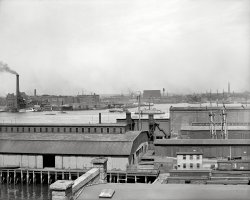
MAY CONTAIN NUTS

Search Shorpy
SHORPY ART

Framed or unframed, desk size to sofa size, printed by us in Arizona and Alabama since 2007. Explore now.
Join and Share
Ad-Free Shorpy
Shorpy is funded by you. Patreon contributors get an ad-free experience.
Learn more.

Recent comments
- Land of the free
- Broad-Exchange Bldg
- Parking innovation
- The old block
- "Peck turned a sweet propeller"
- National Bank Building
- Notch shot
- Straight ahead (right, left, left, right)
- Ship lifespans
- New service
- You Say Station, I Say Potato ...
- Iron Age
- Thank you, Cornelius Vanderbilt
- Grand Central Terminal
- If they made a movie of it
- Obsolete by then.
- Half the tonnage at the NYPANO dock
- Ravages escaped, bank notes signed and dated
- Chatham expansion
- Steepled in History
- Made by York
- No Summer Vacation
- Wait a minute ...
- $$$
- Joad on the Road
- Street Lights Survive
- Now & then
- More or Less? It's a lot less
- A new image.
- Same ol' story ...
Member Photos
The Shorpy
Printporium
Printporium
Search Shorpy
Search results -- 30 results per page
- Ford Target Computor: 1922
- ... Hannibal Ford The Ford Instrument Company, Long Island City, NY, was formed by Hannibal Ford in 1915. It built analog fire control ... which captured Cantigny on May 28, 1918 died Monday in Atlantic Beach, Fla. He was 90.
He was one of the first officers sent ... Posted by Dave - 09/13/2011 - 12:38pm -
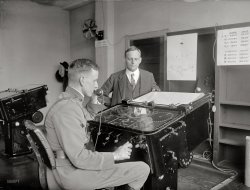
- Jacksonville Skyline: 1910
- ... "Forsyth Street looking east from Hogan." The post office, Atlantic National Bank and Bisbee Building lined up along the city's Bankers' Row, with the Hotel Seminole at right. 8x10 inch glass ... Posted by Dave - 10/11/2022 - 2:09pm -
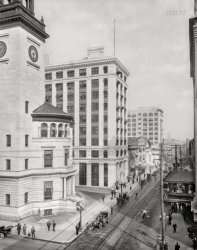
- Who Wants Taffy?
- ... in New Jersey or New York. The concession stand is selling Atlantic City saltwater taffy; the next photo in this series is of a concert at ... Posted by Dave - 11/12/2008 - 10:32pm -
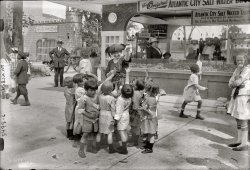
- Smoke on the Water: 1910
- ... didn't get mowed-down in favor of new, shiny ones. The city really retains some of its original character (good AND bad. But mostly ... she was sold to the French government and taken across the Atlantic, converted to the naval patrol vessel Apache. In 1926 she was sold ... Posted by Dave - 08/13/2012 - 6:44pm -
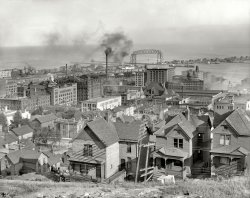
- Multi-Modal: 1908
- ... in the day, thousands of people escaped the heat of the city via the ferries and numerous passenger trains to Atlantic City and other shore points over the tracks of what would become the ... Posted by Dave - 07/30/2012 - 10:09pm -
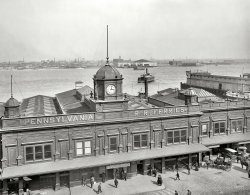
- Castle of Commerce: 1905
- ... That elevated track on the left has got to be the old Atlantic Avenue "L." It would be torn down for scrap 35 years later.
... lanes of dirty, noisy, interstate highway, bisecting the City of Boston from Chinatown to the North End and cutting the waterfront off ... Posted by Dave - 07/27/2012 - 4:51pm -
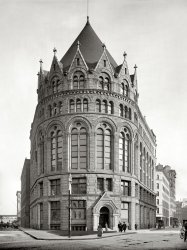
- The Hippodrome: 1905
- ... must have been a precursor to the Steel Pier attraction in Atlantic City in later years.
Old flags There is quite an impressive array of ... Posted by Dave - 08/14/2012 - 8:24pm -
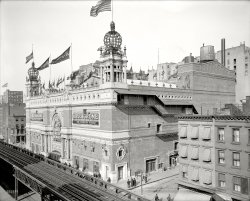
- Boardwalk Empire (Colorized): 1910
- Atlantic City, N.J., circa 1910. "Boardwalk, Hotel Marlborough-Blenheim and Young's ... Posted by Dennis Klassen - 11/14/2011 - 3:12pm -

- La Grande Duchesse: 1901
- ... One of six vessels sunk off the Atlantic coast by a German U-boat on the so-called "Black Sunday" of June 2, ... 1901, Ocean Steamship Co. acquired and renamed her the City of Savannah as she plied the route between New York and Charleston. She ... Posted by Dave - 10/29/2018 - 8:51pm -
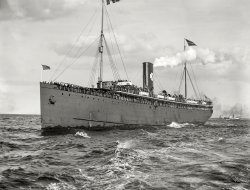
- The Big House: 1925
- ... at the American-British Cowdray Hospital in Mexico City from 1900 until his death in 1959, died Monday after a brief illness in ... In 1961 Col. Seeley and Gerald Halpin, a former officer of Atlantic Research Corp., combined land holdings to build a research and ... Posted by Dave - 08/21/2013 - 6:55pm -
![The Big House: 1925 UPDATE: The location is the old Maplewood estate near Lewinsville in Fairfax County, Virginia; the 1874 Second Empire mansion, at 7676 Old Springhouse Road in what's now McLean, was known as Villa Nuova. The residence was demolished in 1970; whatever connection it might have had to Woodrow Wilson is unknown. Hat tip to Shorpy member Wiggy.
Circa 1925. "Woodrow Wilson house." No other information provided. (Not pictured: Tweety and Sylvester in the parlor, going at it hammer and tongs.) National Photo Company Collection glass negative. View full size.
No Way!When I showed my wife this photo, and casually commented how nice it would be to live in such a big house, she had one comment:
"You better hire a cleaning service, 'cause there's NO WAY I'm gonna be cleaning all those windows!"
Masnard roofThe finest quality Second Empire buildings were usually masonry up to the bottom of the top floor, then wood frame on up. The lightweight wood "Masnard" framing allowed for such free-form, Munster-like extravagances as we associate with the style. Unfortunately, such buildings are notoriously leaky and suffer badly from even short periods of neglect.
[Ahem. The word is MANSARD, not "masnard." -Dave]
Norman and MotherThis house looks perfect for the Bates family.
WOW, beautiful Second Empire house!Any ideas as to where this is/was located in DC? Inquiring minds want to know.
Wilson connectionInformation on Woodrow Wilson's residences is easily available online. What's not so easy is figuring out when, or if, he lived in this house: it's not the Virginia house where he was born; it's neither of his boyhood houses, in Georgia and South Carolina; it's none of the three houses where he lived in New Jersey; and it's not the house he bought shortly before leaving the presidency and where he died a few years later.
Porch ColumnsWhat an interesting detail for the top of those columns. An exquisite house, very handsome. Just need to know the location, nothing else needed.
The RingerWoodrow Wilson is always the name that trips up folks when you ask them to tell you the eight presidents born in Virginia.
Most quickly think of Washington, Jefferson, Madison and Monroe, and may eventually come up with Harrison, Taylor and Tyler. But no one expects a 20th Century president to have been born in Staunton, Va.
Maplewood aka Villa NuovaIn the 60s we used to pass this marvelous house on the way to my father's office and it always fascinated me. It was located on Chain Bridge Road (VA 123) between Vienna and McLean, Virginia, near Tyson's Corner (which I just remember as a real corner--the intersection of two, two-lane roads with a junky little country store).
The marvelous mansard was demolished 1970, alas -- but at least HABS took photos. I don't know anything about a Woodrow Wilson connection.
[Thank you, Wiggy! - Dave]
PuzzledWhy have so many of these lovely houses that appear in Shorpy pictures been demolished?
[House old and decrepit, land value increases, owners sell out. - Dave]
Why, thank you, Thing!Photo brings another family to mind:
They're creepy and they're kooky,
Mysterious and spooky,
They're all together ooky,
The Addams Family.
Their house is a museum
Where people come to see 'em
They really are a scream
The Addams Family.
Snap, snap!
MapleWood A 1956 newspaper article below refers to the house as, "the summer home of Woodrow Wilson." I can't find any contemporaneous accounts to confirm that but then it is probably not the sort of thing reported in newspapers. Owners included Brigadier General William McKee Dunn in the 1870s and Charles Brodt in the 1910s. Sidney and Ethel Ulfelder bought the property in the late 1920s and held it for 5 decades. Control of the property was passed to their son-in-law Rudolph Seeley, who quickly razed the building soon after Mrs. Ulfelder's death before it could be declared a historic landmark.
Washington Post, July 30, 1956.
McLean Seeks U. of Va. Branch
A McLean, Va., group came forward with a last-minute proposal yesterday for the location of the Northern Virginia branch of the University of Virginia at the historic Maplewood estate of Dr. and Mrs. Sidney Ulfelder. They also suggested that the proposed Fairfax County Hospital be located on the property.
The 500-acre estate, which includes a 24-room mansion which at one time was the summer home of Woodrow Wilson, will sell for $2500 an acre, they said. …
The McLean Group, made up of French Trammell, Robert A. Alden and O.L. Brandenburger, met yesterday with Col. Rudolph G. Seeley, manager of the estate and son-in-law of the Ulfelders. …
Washington Post, November 12, 1969.
Ethel Ulfelder, 84, a major land owner in Fairfax County and the widow of Dr. Sidney Ulfelder, a physician at the American-British Cowdray Hospital in Mexico City from 1900 until his death in 1959, died Monday after a brief illness in Mexico City.
She owned the 512-acre Maplewood Farm, part of which is now the Tysons Corner shopping center, the Westgate Industrial Park and nearby sections of what is now the Beltway and Dulles Airport access roads. The old Maplewood house itself is now the Westgate office, on Rte. 123 in McLean. …
Washington Post, February 25, 1970.
Wrecking Crew Steals March on History Buffs in Fairfax
Wrecking crews stole a march on history buffs last weekend. A 100-year-old Victorian mansion the buffs had hoped to preserve was demolished and apparently none of them know anything about it until it was too late.
The 24-room, yellow-painted brick home, known as Maplewood, was torn down at the Westgate Research Park near Tyson's Corner to make way for construction of another industrial building. …
“We are just terribly depressed, surprised and shocked,” said Joyce Wilkinson, chairman of the Fairfax County Historical Commission. She and other commission members claimed that Rudolph Seeley, executive vice president of Westgate Corp., told them last October that the structure would not be torn down for up to three years and not sooner than one year.
Seeley said the demolition was ordered because the “house is standing on very valuable, highly taxed land” and was “not a particularly architectural gem under any stretch of the imagination.”
Washington Post, January 6, 1988.
Col. Rudolph G. Seeley, 72, a Fairfax County civic leader and developer who helped pioneer the explosive commercial growth of the Tysons Corner area, died of cancer Jan. 4 at his home in McLean. …
It was not until after the war that Col. Seeley moved to the Washington area. The family of his wife, the former Martha Ulfelder, had been farmers in the Tysons Corner area since the 1920s, and the colonel became manager of their dairy business during the late 1950s. Construction occurred between 1958 and 1964. There were 14 interchanges on the highway in Fairfax County alone. The idea that major commercial development would take place so far from downtown Washington was thought to be preposterous. Where the Beltway passed near Tysons Corner there was a feed store, a gas station, a restaurant and a general store. Much of the Ulfelder farm was taken for the Beltway right of way. Mindful of development opportunities, Col. Seeley led a group in acquiring more acreage with a view to rezoning it for commercial use.
The wisdom of this move was affirmed with construction of the Dulles Airport Access Road. The Seeley-Ulfelder holdings were at the intersection of Rtes. 7 and 123, roads that had existed since Colonial times. With the building of the Beltway and the Dulles Access Road the land was better served by major highways than any location in Northern Virginia. In 1961 Col. Seeley and Gerald Halpin, a former officer of Atlantic Research Corp., combined land holdings to build a research and industrial park and they helped found the Westgate Corp. to carry out their plans. Col. Seeley also was part of a partnership that leased land to Maryland builders who erected the Tysons Corner Center. It opened in 1968 with three anchor stores and about 70 smaller businesses. …
Bravo!Best Shorpy caption ever!
(The Gallery, D.C., Natl Photo)](https://www.shorpy.com/files/images/SHORPY_30583u1.thumbnail.jpg)
- Euclid Avenue: 1911
- ... Supreme Hive, ladies of the Maccabees, now in session at Atlantic City, N.J., will adjourn and come to Cleveland in a special train to take part ... Posted by Dave - 07/30/2012 - 10:52pm -
![Euclid Avenue: 1911 Cleveland, Ohio, circa 1911. "Euclid Avenue, east from Public Square." A close-up of the greenery at the base of the Soldiers' and Sailors' Monument seen in the previous post. 8x10 inch glass negative, Detroit Publishing Co. View full size.
Working on the streetcar lineI love the guy on a ladder, apparently brought by a cart pulled by a horse, working on the streetcar line. I can imagine the old timers complaining about those new fangled electric car lines, as opposed to the good old fashioned ones pulled by horses or donkeys.
Problem solvedI had to wonder what the designs of the various flower beds were, they are insignias of different Army corps.
Looks like a summer day.I feel sorry for those people, so heavily dressed. Back then the most people had to cool off would have been an electric fan blowing over ice. In that respect, it's much easier to get cool and stay cool now. But, hey, I've always been cool, heh, heh.
First Traffic LightIts no wonder the first traffic light was installed at 105th and Euclid Ave.
I believe the first electric traffic light was also invented in Cleveland.
K.O.T.M.Knights of the Maccabees. A fraternal organization inspired by Judas Maccabeus. Their lodges were called "tents." Eventually morphed into an insurance company.
They seem to have drawn quite a crowd to the May Co.
[The crowd itself might be the Maccabees. There were signs all over Cleveland, including the banner across the street, welcoming delegates to the Maccabees "encampment" (the first quadrennial and 12th international convention) in July 1911. - Dave]
MACCABEES ARE IN CAMP
UNIFORM RANK DELEGATES
FROM 11 STATES GATHER.
CLEVELAND, OHIO, July 16. -- In falling rain Camp Cleveland of the national encampment of the uniform rank of the Knights of the Maccabees was formally opened in Edgewater park here today with about 500 uniformed knights present. They represent 43 divisions and 11 states. The encampment is being held in conjunction with the quadrennial review of the Supreme Tent, the national legislative body. The latter will begin its sitting next Tuesday.
In addition the Supreme Hive, ladies of the Maccabees, now in session at Atlantic City, N.J., will adjourn and come to Cleveland in a special train to take part in the social and business features of the convention. An important matter to come before the Supreme Tent is the plan for three big homes and sanitariums of the order. If favorably acted on the first institution will possibly be located in or near Cleveland, and built at a cost of from $200,000 to $300,000.
Euclid, Euclid everywhereCan someone please explain to me why so many cities have streets named Euclid? Did the "Father of Geometry" really have that many fans among city planners in the 19th Century?
Nice LawnWhat a well manicured lawn. Had gasoline powered lawn mowers been invented yet?
[I think the gardeners probably used a reel mower. - Dave]
That Euclid really got aroundHere in southern California, I know of streets named for Euclid in Ontario, Fullerton, and East Los Angeles. I suppose the folks laying out roads have a liking for him and his geography geometry. And as a kid I had a die-cast model of a piece of Euclid road-building equipment.
Hyperfocal DistanceI've always been impressed at the sharp focus of photos like this. Does anyone who knows more about the mechanics of cameras from this time period know if the photographers focused their cameras at the hyperfocal distance to assist in achieving this outcome?
+105Below is the same view from July of 2016.
(The Gallery, Cleveland, DPC, Streetcars)](https://www.shorpy.com/files/images/4a25313a.thumbnail.jpg)
- St. Michael's Episcopal, Charleston: 1865
- ... South Carolina, in 1865 following bombardment of the city during the Civil War. From photographs of the Federal Navy and seaborne expeditions against the Atlantic Coast of the Confederacy, 1863-1865. View full size. Left half of ... Posted by Dave - 06/16/2011 - 2:15am -
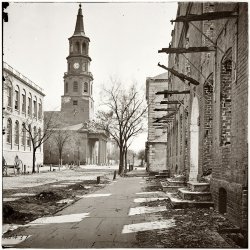
- Xanadu: 1897
- ... Also, I understand that these were hotels built by th Atlantic Coast Line Rail in order to build up the area and hence business for ... tentacles of the rail octopus Many of the streets in my city were named for railroad barons, including Flagler.
Two Major Reasons ... Posted by Dave - 08/13/2012 - 7:57pm -
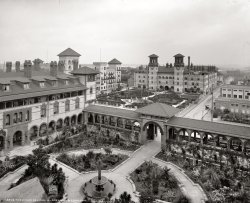
- Turnaround Time: 1905
- ... forever - on their way to Army camp, or the even bigger city of New York, or perhaps about to seek their fortunes further West...
... a dollar across the Delaware. But the 55 mile trip to Atlantic City by electric train sounds attractive.
Re: Five Minutes Later ... Posted by Dave - 08/14/2012 - 12:33pm -
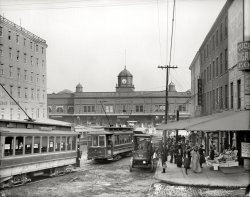
- Too Much Fun: 1905
- ... they will be used at other resorts, such as Coney Island, Atlantic City, Deal Beach, Washington Heights and Niagara Falls. …
The ... Posted by Dave - 08/05/2012 - 1:49pm -
![Too Much Fun: 1905 New York circa 1905. "Dreamland Park at Coney Island." Among the amusements to be sampled: An observation tower, the Bostock trained animal show, a Baltimore Fire cyclorama, the General Bumps ride, a miniature railway, Will Conklin's Illusions, the Temple of Mirth and Hooligan's Dream. 8x10 inch dry plate glass negative, Detroit Publishing Company. View full size.
Oil burnersThese were oil burning steam locomotives.
The Miniature Railroad was built by the Cagney Brothers in 1904 to replace an earlier version that was lost in a November, 1903 fire. It made a circuit of the park running underneath the promenade. The locomotives, which could pull three of the two-passenger cars, were built by the Cagney Brothers' Miniature Railway Company in New York. Their ad below is from the February 7, 1903 issue of The Billboard.
An earlier Shorpy post with a closeup of one of the locomotives has more information here, and a 1903 Edison silent movie of Coney Island before the fire (found here) shows the train emerging out from under the promenade at the 7:44 minute mark.
You Can't Miss MeI'll be the one wearing a mustache a hat and a dark suit. The cops must have had an awful time with witness descriptions of the perps back then.
Where to look first?There are so many wonderful aspects to this picture, I hardly know what to take in first. I love the "Temple of Mirth" (Can you imagine "mirth" being used on a ride today? How many folks even know what it means anymore?) I also love the "Hooligan's Dream" (but ditto on the meaning being mostly lost on 21st century folk). What REALLY intrigues me however, is what the people in the forefront are looking at instead of the elephants right behind them, which I would be fascinated by. Surely elephants weren't a commonplace sight.
[Happy Hooligan, whose image is in the circle on the sign, was an extremely popular comic strip character of the time. - tterrace]
Soon to be gone - againDreamland was rebuilt in early 1904 after a disastrous fire destroyed it in November, 1903. Six years after this picture was taken this scene was again destroyed by fire. It made news even in far away Australia where, two days later, the tragedy was reported by The Argus newspaper.
FIRE AT CONEY ISLAND.
AMUSEMENT PALACE DESTROYED.
DAMAGE 3,000,000 DOLLARS.
NEW YORK, May 27.
A destructive fire occurred yesterday at Dreamland, one of the great amusement resorts at Coney Island, New York. The damage is estimated at 3,000,000 dol. The menagerie was destroyed, 50 wild animals being cremated. The adjoining place of entertainment, Luna park, was saved.
[Dreamland and Luna Park practically constitute Coney Island, which is the greatest resort of its kind in the world. The resources of inventors are taxed to provide new thrills, with the result that each season finds some ingenious novelty installed for the New York clerk and shop-girl. Dreamland contains dozens of forms of entertainment. The visitor may travel by captive airship, or glide at fearful speed down the chute, through a cascade of real water. He may "loop the loop" in a car, or travel in a small chariot over an undulating sea of metal, the waves of which are caused by machinery below. The "Rocky Road to Dublin, " a fearful switchback apparatus, and "General Bumps," involving a hazardous slide down a polished wooden surface, are among the joys of the place; while those who desire to visit other lands may take a trip to the North Pole or the wilds of Central Africa with equal ease and cheapness.]
A more complete newspaper story with pictures of the aftermath can be found here, and a few more pictures can be seen here and here.
The steam locomotivehas been hooked up to some pretty fancy oversized cars, and can you believe observing HYENAS for 25 cents, forget lions and panthers, they've got HYENAS !
Bostock's Wild Animal Exhibition
Broadway Magazine, April 1905.
Although Coney Island has improved greatly in the character of its shows within the last few years, the same atmosphere of careless holiday-making prevails, and you always have a feeling of jolly irresponsibility as you go from one place of amusement to another.
Bostock's wild animal exhibition in “Dreamland,” is again a prominent feature of the summer. The animals are interesting, whether in their dens or in the arena, while the trainers who put the savage creatures through performances in the large steel cage are as impressive as ever.
There was one act I saw at Bostock's lately which struck me as particularly good. A young lady in short skirts, who was announced as “La Belle Selika,” skipped into the cage with seven—I think it was seven—lionesses. She made them get up, reluctantly, upon pedestals in different parts of the cage. Then, as the orchestra struck up the music of the “Pretty Maidens,” in “Florodora,” she danced, teasing the animals by pointing her slippers at them one after another, and retreating just far enough to escape the angry paws darted at her each time. They seemed eager to tear her to pieces. She pirouetted about the creatures, always close to them, but just far enough away to avoid being clawed, until at last she struck an attitude immediately in front of the most savage of her pets and smiled in response to the applause, while the lioness growled. It was decidedly the prettiest act I ever saw in connection with trained wild animals, and it looked fearfully dangerous, whether it was so actually or not
Live Steam?I would assume that that little locomotive was actually a steam powered kerosene burner... does anyone know?
UPDATE: The kerosene assumption was (wrongly) made because I couldn't imagine firing a firebox that small with coal to maintain a working head of steam - Ausonius.
Pigmy Locomotive While the Cagney Bros. operated many miniature railway concessions, the actual builder of this engine was the McGarigle Machine Co, of Niagara Falls, NY. Tobbacconist, is there something in the photo that indicates oil as the fuel source? The following article states the originals were built with a 10 inch firebox burning anthracite. I think this engine is coal fired. In 1905, coal was still a widely available and familiar fuel. Also, the trousers on the engineer appear rather well coated in coal dust. [Additional information and photos.]
The Railway Age, July 1, 1898.
A Pigmy Locomotive.
What is claimed to be the smallest locomotive ever made for drawing passenger cars has been made for the Miniature Railroad company by Thomas E. McGarigle of Niagara Falls. This steam railroad is to be operated at the Trans-Mississippi Exposition in Omaha, Neb., and, in all, six locomotives are to be built for the company under the present contract. It is possible they will be used at other resorts, such as Coney Island, Atlantic City, Deal Beach, Washington Heights and Niagara Falls. …
The height of the locomotive from the top of the stack to the rail is 25 inches, and the gauge is 12½ inches. The cylinders are 2x4 inches. The boiler is 1½ horse power, made of steel, and is tested to 300 pounds pressure, and will hold 24 gallons of water. …
The firebox is 10 by 10 inches. The weight of this little engine is about 600 pounds, and it will run on a rail three-quarters of an inch square. Hard coal will be used as fuel. The capacity of the locomotive is 10 cars, each containing two persons, or about 4,000 pounds. The locomotive is equipped with sandbox, bell, etc., and has a steam brake between the drivers. One man, whose position will be on a seat in the tender, operates the engine. The scale on which the locomotive was built is about one-seventh that of one of the New York Central's largest engines, and as it stands in the shop it has a very businesslike appearance, as shown by the illustration.
Live Steam Model FuelsThere`s no guarantee or requirement that this locomotive is oil fueled. Even today Live Steam enthusiasts operating large scale locomotives are running with a variety of fuels. Propane is popular as is oil or kerosene. However coal is still the most popular fuel for ridable trains like this and can be used at gauges as small as 1.26 inches. So unless there were other considerations, like local laws, there`s a high likelihood that this engine was coal fired.
All in the FamilyYes, a great number of the 'Cagneys' (as they were known) were built in the Niagara shop of Thomas and Peter McGarigle; however, since their sister Winifred married Timothy Cagney, it was considered to be all in the family. Peter—an engineer—was mostly likely the one who designed the first of the miniature locomotives, ostensibly in 1885. In the early 1890s Timothy and his brothers David and John, were running a ticket brokerage company known as Cagney Bros. in New York, but by 1898 decided to fully concentrate on marketing the McGarigle locomotives and so incorporated The Miniature Railway Company, of Jersey City.
For years the two businesses were nearly indistinguishable from one another, and were in fact interchangeable as far as miniature railways were concerned, as they worked together on various projects. In 1903 the Cagney Bros. Co. was ensconced in the Planter's Hotel in St. Louis—there to build the eight mile miniature railroad that would run through the grounds of the St. Louis Purchase Exposition (the 1904 World's Fair). Timothy Cagney was listed as President, and Peter McGarigle as Chief Engineer. While the Cagney Brothers' Miniature Railway Company was selling the vast majority of the McGarigle railroad oriented output, the Niagara firm was still peddling their own product as late as 1915 when they made a proposition to the City of San Francisco to operate a miniature railway in the park.
By the 1920s however, the Cagney Bros. had absorbed the miniature railway portion of the McGarigle Machine Company, and McGarigle's—once also known for their gasoline marine engines—appears to have been reduced to being an automotive machine shop. The locomotive building operation was now referred to as "the Cagney Brothers' Amusement Company Niagara Falls plant." By the 1940s the late Timothy Cagney—and not Peter McGarigle—was being given credit as the inventor.
According to one report, two of Cagney's "best known installations were two gold-plated trains with steam locomotives built for the King of Siam, and the 'Trip Around the World' exhibit at the New York World's Fair of 1939 and 1940."
As for the oil burner reference, it's from a list of Coney Island rides and shows complied by Kingsborough Community College Professor Emeritus (and former Brooklyn Borough Historian, director and archivist) John Manbeck. He complied a vast collection of Coney Island ephemera that has since been donated to the Brooklyn College Library. On his list of rides and shows is this entry:
A Miniature Railroad built by the Cagney Brothers made a circuit of park beneath the promenade. Each of its three small cars, pulled by a small oil-burning steam locomotive, held two passengers.
I do not know what his original source was (but I'll try to find out); however, while the vast majority of the McGarigle/Cagney locomotives were coal-fired, it makes sense that these would be oil-fired as it would have virtually eliminated the fear of sparks from the smoke stack—especially so soon after the disastrous 1903 fire.
(The Gallery, Coney Island, DPC, Railroads)](https://www.shorpy.com/files/images/SHORPY_4a17574a.thumbnail.jpg)
- House Party: 1950
- ... like the tag hanging from a beach locker key in a Shorpy Atlantic City photo.
[Sweet 17. - Dave]
On display: A lot of clavicle.
... Posted by Dave - 08/30/2013 - 10:59pm -
![House Party: 1950 1950. From photographs by Stanley Kubrick for the Look magazine article "The Debutante Who Went to Work": "Socialite model/actress Betsy Von Furstenberg attending a weekend house party. Includes Von Furstenberg, hostess Sandra Stralem and other young women in ball gowns." View full size.
Smoke? Don't mind if I do! (Two women on the left)
CharmingOne of the girls is wearing what could be a heart shaped charm dangling from a bracelet with the number 17 on it. That makes it look like the tag hanging from a beach locker key in a Shorpy Atlantic City photo.
[Sweet 17. - Dave]
On display:A lot of clavicle.
I STEPPED on the ping pong ball!This looks the kind of crowd Gloria Upson ran with (Auntie Mame). Is that Muriel Puce I see?
Voice Activated Light Stand"Can you hold that light a little higher for me?"
Mirrors and other reflective objects in the background cause headaches for all photographers. In this case it clearly shows the guy holding a light and a woman (chaperone maybe?) looking on.
I can almost hearthe crinkling sound of all that fabric every time any of our ladies move around, even a little, plus I can almost smell the strange mix of 1950s hairspray and perfumes certainly saturating that room.
If I could turn back timethis is precisely where I would be. Great shot!
(LOOK, Pretty Girls, Stanley Kubrick)](https://www.shorpy.com/files/images/SHORPY_03683u.thumbnail.jpg)
- Grease: 1925
- ... Boulevard near today’s Rodeo Drive; Cotati, Culver City, Fresno and San Carlos, plus two circle tracks, Oakland and Playa del ... Bridgeville and Uniontown; Akron and Cincinnati, Ohio; Atlantic City and Woodbridge, New Jersey, Charlotte, Chicago, Des Moines, ... Posted by Dave - 10/22/2012 - 10:54am -
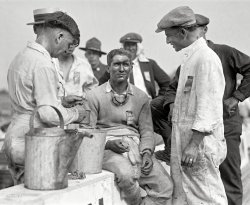
- Par Avion: 1918
- ... and what not, but it was a real challenge to fly from one city to another back then. No radio, no radar, almost no onboard instruments ... trying to fly from Washington to Philadelphia. “The Atlantic Ocean and lack of gas prevent him going further,” Fleet said.
... Posted by Dave - 08/28/2012 - 1:41pm -
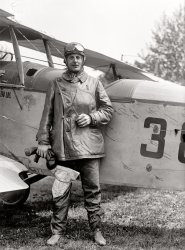
- Cures Malaria: 1903
- ... for, and for the erecting of, a Cathedral Church in the City of Baltimore”. Also he gave his employees the opportunity to become ... are two Bay steamers of the Baltimore, Chesapeake and Atlantic Rwy tied up at their freight terminal. Most of these waterfront ... Posted by Dave - 08/21/2012 - 7:52pm -
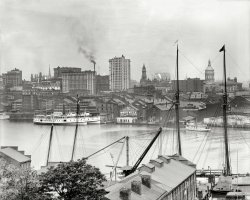
- Corner Time: 1916
- ... room and freezing in another.
A&P The "Great Atlantic & Pacific Tea Company" visible on the left in the background was ... and explain our rates, which are the lowest offered in the city. Loans paid off and more money advanced. Tel. Main 4373.
... Posted by Dave - 08/06/2012 - 1:58pm -

- Joe's Jungle Bungalow: 1904
- ... a "rolling chair" along the lines of the ones seen in the Atlantic City photos.
[Below: At the Royal Poinciana in Palm Beach, home of the ... Posted by Dave - 08/25/2012 - 4:56pm -
![Joe's Jungle Bungalow: 1904 Palm Beach, Florida, circa 1904. "Alligator Joe's bungalow in the jungle." 8x10 inch dry plate glass negative, Detroit Publishing Company. View full size.
Jungle CapitalismOne thing that can be said about Joe, he has the entrepreneurial spirit. He knew how to market his alligators and his residence.
Here's the great man himself!Alligator Joe poses at entrance to main pavilion. http://royalpoincianahotel.blogspot.com/
Out of the movies?This looks like Tarzan or Dr. Livingston should live here!
Thatch MastersThere is still a solid demand for thatched roofs down here. Every beach hotel with a tiki bar has one, in addition to many inland hotels striving for that "beach" ambiance. The Seminoles build the best ones.They also run a pretty mean casino.
I wonderif anyone called it Alligator Joe's Bungalow in the Jungle-O.
I know I would have.
Soft drinks, cigars, peanuts and piesWhat else would you need, except of course a baby carriage and a duck?
[I think that's more of a grownup carriage. And a rooster. - Dave]
Before televisionThis is what Captain Kangaroo might be up to.
A Rooster?That rooster sure looks to me like it has a bill and webbed feet.
[We'll put someone else in charge of the chicken house. - Dave]
Rolling ChairThat's a "rolling chair" along the lines of the ones seen in the Atlantic City photos.
[Below: At the Royal Poinciana in Palm Beach, home of the bicycle chair. - Dave]
(The Gallery, DPC, Florida)](https://www.shorpy.com/files/images/4a11871a.thumbnail.jpg)
- Kittatinny House: 1905
- ... you like to visit the seaside and see Coney Island or Atlantic City back then and wander up or down the boardwalk? What would it be like to ... Posted by Dave - 07/30/2012 - 4:37pm -
![Kittatinny House: 1905 Circa 1905. "Kittatinny House, Delaware Water Gap, Pennsylvania." 8x10 inch dry plate glass negative, Detroit Publishing Company. View full size.
Huh?Excuse me but are those curtains on the outside of the window?
Need A BreakThe gentleman to the left looks to be taking a break from the food service area to have a smoke.
Natural telephone polesNotice the trees on the right are used for telephone poles.
Any trees left after it was built?Wow...what a monster.
Imagine the maintenance required....paint...shutters, shingles.....ice.
CurtainsThey may have been used to keep insects out - like a screen window
Tree powerInteresting use. Trees don't grow upwards their whole length but only at the top. The trees grow in girth. So at least the lines won't move up through the years. The standoffs might evidentially be engulfed in the outer layers of the tree.
A stream runs through itOne unique feature of Kittatinny House was the mountain stream that ran through the kitchen (I hope it was planned that way). The road we see with the horses and buggy is now Route 611, with I-80 down below along the Delaware River, which divides New Jersey and Pennsylvania here at the Delaware Water Gap. Nearby is what's described as the best rock climbing in New Jersey.
Here's the fountain we see at the far end of Shorpy's photo. Dave, would all this light come from one Mother of All Gunpowder Flashes?
NPS informationA user-friendly pdf of the Park Service's Spanning the Gap newsletter provides background and a map of the resort.
Just a memoryThe best I could find out is that there are ruins of the fountain and the stone ovens.
[It was destroyed by fire in 1931.]
Dreaming of a Different TimeI see these pictures on Shorpy of the way people lived and played back in those days and I feel left out that I cannot experience the same. Wouldn't it be great to take a trip on a river boat like the stern and side wheelers we see in these photos? Even just a day trip down river and back. How would you like to visit the seaside and see Coney Island or Atlantic City back then and wander up or down the boardwalk? What would it be like to stay in one of the big hotels or popular inns that are featured in these photos? Actually, a lot of us would not have been fortunate enough to afford a trip or a vacation to some of these places. Money was as tight then, or tighter, than it is now. But it is nice to dream and just imagine that you are there enjoying the sights and sounds.
[It was destroyed by fire in 1931.]Well of course it was, was there ever any doubt?
(The Gallery, DPC, Horses)](https://www.shorpy.com/files/images/SHORPY_4a12791a.thumbnail.jpg)
- Motor Check: 1924
- ... The fellow with the cigar could be cast as one of Nucky's Atlantic City henchmen.
BHP Figures could top 50 BHP back in this time. Why ... Posted by Dave - 09/28/2013 - 12:10pm -
![Motor Check: 1924 Washington, D.C., 1924. "Havoline Oil Co." Participants in the "Wasson Motor Check" at the Texaco Station on the corner of Florida Avenue and 14th Street. National Photo Company Collection glass negative. View full size.
Just Love It!Nothing more to say.
Dynamometer granddaddyThis must be the grandfather of all chassis dynamometers.
Checking it outThe fellow with the cigar in his mouth is in charge of checking for gasoline leaks.
Quiet Please!Man sitting in window on the right to his wife: "It's hot, there's no AC, and with this window open all we hear is those motors running. We gotta move!"
BoardwalkerThe fellow with the cigar could be cast as one of Nucky's Atlantic City henchmen.
BHPFigures could top 50 BHP back in this time. Why bother?
Excellent, Lo-Tek motor condition checkThey're checking the level of "blow-by" gasses. Modern cars (since 1965 in Calif) re-burn these fumes via the PCV system. In those days, a draft tube spewed them into the air.
Higher readings = worn piston rings and/ or valve seats.
additional symptoms: Heavy blue smoke & power loss.
Solution: Overhaul. much less expensive in those days.
With the inferior oils & metallurgy of the day, overhauls could come every 10,000 miles or so. These guys & their device could give you a pretty good idea how much longer your motor would last.
Tired"John R. Pendleton," the name on the tire cover, was only a Studebaker dealer for about two years. The cover is interesting because it appears to have been designed to fit a variety of tire sizes (note the extra snaps near the top). In addition to being a Studebaker dealer circa 1923 - 1924, he was a Nash dealer in 1926. Two of his advertisements from D.C. city directories are below.
Pendleton was born in Westmoreland County, Virginia in 1888 to Robert and Sophie [Rust] Pendleton. He was a chauffeur and machinist before becoming involved in automobile repair by 1914 until around 1917. His first stint at selling vehicles was with Standard Auto Service Company where he sold Federal Trucks as well as the Truxton truck attachment. This device converted a car into a truck by means of a replacement rear axle and frame extension (picture below).
Where he worked between his year or two of selling Federal Trucks and the time he began selling Studebaker's isn't clear. After he stopped selling Nash cars, he was employed by Studebaker Corporation of America in their D.C. office before he moved on to selling cars at Wallace Motor Company in 1929, which sold Nashes, in the District for a couple of years.
The 1930s saw him back in the auto repair business, operating a gas station, and a five year run as the superintendent of an apartment building which continued into the early 1940s. By 1942 he was working at a mortgage and real estate firm that belonged to his uncle Harry Lee Rust.
Eventually he and his wife Marie moved to Florida where she passed away in 1971. John Pendleton apparently moved back to the D.C. area, and he died at the age of 88 in Maryland in 1976.
Free CheckProminent in some advertising was the fact that the Wasson Motor Check was free. While the test may have been free, the cost of the oil was not for the customer. You also needed to make two visits to the check station. The first visit was to have your oil changed and to make an initial test of your engine and record the results. Approximately 200 miles later, you needed to return and have the engine retested. The card below shows sample measurements after the second test.
Period documents state that the Wasson Test Stand was leased to the service station/garage. In addition to measuring gas leakage past the cylinders mentioned by "zumma" below, it also had a still for measuring oil dilution, and a flow meter for measuring gas consumption. A close-up of one of the gauges, which was made by the same company that made the MotoMeter radiator temperature gauges, is shown in the Shorpy photo is below.
More details of the Wasson Check Station can be found in a November 15, 1924 Petroleum Age article here, and the patent is here. At the same Petroleum Age link there is a short summary of how the whole system worked on page 55 of the August 15, 1924 issue, as well as more details if you search the issue for "Wasson."
(The Gallery, Cars, Trucks, Buses, D.C., Gas Stations, Natl Photo)](https://www.shorpy.com/files/images/SHORPY_31266u.thumbnail.jpg)
- Sorry, Full: 1953
- ... Another in a series of professional 8x10 pictures taken in Atlantic City in August 1953 for Better Living Magazine, featuring my in-laws. View ... Posted by Born Too Late - 06/08/2013 - 6:37pm -
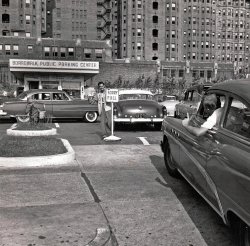
- In the Driver's Seat: 1915
- ... By fall she was performing fast exhibition driving at Atlantic City and at the Fair in Poughkeepsie, where she ran against Barney Oldfield and ... Posted by Dave - 08/29/2012 - 2:12pm -
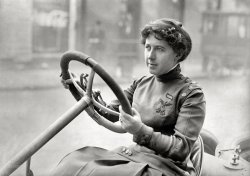
- Long May She Flap: 1924
- ... represented the District of Columbia as Miss Washington in Atlantic City and, as Miss Treasury Department, led a fashion revue in "Uncle Sam's ... Posted by Dave - 07/05/2009 - 2:59am -
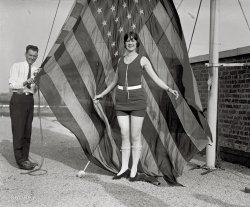
- Haunted Saloon: 1906
- ... Grandparents lived in Belle Chase; shopping trips to the City, by ferry, with stop for oysters and hot sauce with Regal Beer in Gretna ... With the AT&T breakup it became part of Bell Atlantic and the name was lost. Bell Atlantic became Verizon. C&P seems ... Posted by Dave - 11/17/2017 - 2:35pm -
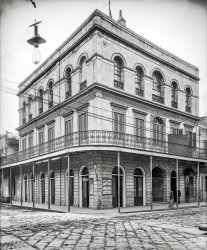
- Me and My Shad: 1920
- ... fascinated by the old urban photos, especially of New York City, would likely be fascinated by Mitchell's writing.
Bad shad I've ... the most valuable of the migratory river fishes of the Atlantic seaboard, will become unknown in Chesapeake Bay and the Potomac River. ... Posted by Dave - 09/13/2011 - 1:33pm -
![Me and My Shad: 1920 Circa 1920. "Shad fishing on the Potomac." National Photo Co. View full size.
"Gluttonous Springtime Blowouts"Here's a quote about shad bakes from catfish1.com
During the shad's Hudson River heyday, virtually every river town could boast at least one big annual shad bake—the Hudson's equivalent of the New England shore dinner. New Yorker essayist Joseph Mitchell, in his 1959 piece "The Rivermen," calls these bakes "gluttonous springtime blowouts" and remembered when huge bakes were given by churches, lodges, labor unions, and local politicians.
"The Rivermen" was a long essay for the New Yorker. It was later collected in Mitchell's "The Bottom of the Harbor," which itself was later collected in the masterpiece "Up in the Old Hotel."
Joseph Mitchell was from a small town in North Carolina; after graduating from college, he moved to New York, where he reported for several newspapers and eventually began writing for the The New Yorker in 1933. He worked there until his death in 1991, although he effectively stopped writing in 1964. Shorpyites who are fascinated by the old urban photos, especially of New York City, would likely be fascinated by Mitchell's writing.
Bad shadI've always thought of shad as a trash fish. Were they considered more desirable in 1920 or is there something I don't know about them?
[Planked shad was practically a religion in this part of the country. And shad roe is considered a delicacy by many. - Dave]
Blind to their Own InterestsShad were once plentiful in the Potomac, Delaware and Hudson rivers. Overfishing and pollution were greatly reducing their numbers at the time of this photo. Due to efforts to stock the river with fry and roe, the population in the Potomac lasted a few years longer then those in the Delaware and Hudson. There is now an ongoing project to restore shad to the river.
On a culinary note, in addition to planked shad for dinner, newspapers of the time mention bacon-garnished shad roe as a popular breakfast treat. Of course making a delicacy of the thousands of eggs in each fish no doubt hastened their decline.
Additionally, please don't interpret the title of this post (Blind to their Own Interests, extracted from one of the following newspaper articles) as a condemnation of the hard-working fishermen of the time. Overfishing, as in many exploitations of shared resources, is due to the larger dilemma of the Tragedy of the Commons.
Washington Post, Dec 20, 1915
Driving Out Potomac Shad
Fish Will be Gone Says Commission,
if Greedy Catch Isn't Stopped
Unless protective measures are taken at once by the State of Maryland and Virginia there is a danger that the shad, the most valuable of the migratory river fishes of the Atlantic seaboard, will become unknown in Chesapeake Bay and the Potomac River.
A real note of alarm in this respect was sounded in the annual report of the government bureau of fisheries, which was issued yesterday. Not only is it indicated that the fisheries laws of Maryland and Virginia should be amended, but the laws of all the Atlantic coast States as well.
"The bureau repeatedly has pointed out the shortsighted and destructive course pursued by some of the States with reference to this most important fish," the report said. "The most serious condition exists in the Chesapeake basin, where in 1915, the fishing was the poorest ever known, following a season that was the poorest in a generation. No limits are placed on the operations of the fishermen, who seem blind to their own interests. Every stream which the shad can try to ascend is literally choked with nets.
Washington Post, Nov 27, 1925
Fish Disappearing
Commissioner O'Malley, of the Bureau of Fisheries declares in his annual report that the country is at last awakening to the need of conservation if serious depletion of some of the most important American fisheries is to be checked. ...
A few years ago shad visited the waters of the Potomac in sufficient numbers to enable the proprietors of the resorts along the shores between Washington and Indian Head to offer a round trip ticket on their steamers with a "whole planked shad and a moonlight ride on the return," all for a dollar. In those happy days fishermen offered the choicest "roe shad " at the height of the season for "a levy," and itinerant peddler would bring one to your door, all dressed, for a quarter. Frequently when the fish were "runnin' strong" they were a drug on the market, to be had for carrying them away. Farmers along both shores of the river salted hundreds of barrels of shad and herring every spring, while "Potomac Robins," as the herring were known, were the staple food of most of the colored laboring class.
1914 Advertisement
Washington Post, Jul 22, 1926
Will The Shad Come Back?
...
Thousands of citizens not yet out of the "thirties" can remember when the fish peddler cried his wares through the streets of Washington early in the spring when a roe-shad big enough for a family dinner could be purchased for a "quarter." But there has been a gradual falling off in the catch every year for more than a decade and last May, in the height of the season, the haughty fishmonger scorned the dollar proffered for an insignificant "buck."
The United States fish commissions has carried on restocking operations in the Potomac during the past nine or ten years. This season the number of fry turned into the river at the hatchery opposite Mount Vernon was the smallest in years. There were 10,000,000 fingerlings released from the hatchery. In some years the number has reached 80,000,000 and the commissioner is still hopeful that results will be shown in the returns from the seine haulers.
The falling off in the number of shad caught in Northern waters can only be explained by the growth of cities on the banks of the rivers and the erection of all sorts of manufacturing plants along the shores which have resulted in the pollution of the waters and killed off young fish by the millions. ...
Oh, waiterThe popularity of shad roe is illustrated in the Cole Porter song "Let's Do It" with the line "Why ask if shad do it? Waiter, bring me shad roe."
Fish storyShad fishing in the Hudson River remained a major seasonal activity until well into the 1950's: the rivermen would live on their boats/barges during the shad run. Some time earlier, large sturgeon were plentiful enough on the Lower Delaware that there was a town (Caviar) built around the harvesting of their roe. The Central Railroad of New Jersey had a freight line serving the town.
Not much left of that now.
ShadHere on the Tennessee river, shad are used for cut bait on trot lines. You have to cut up a shad and get the pieces on the hooks as they don't "keep very well" in warm weather.
(The Gallery, Boats & Bridges, D.C., Natl Photo)](https://www.shorpy.com/files/images/18293u.thumbnail.jpg)
- TTerrace Terraces: 1979
- ... When, at the age of 11, I incorporated the yard as the City of Penton, I named those pathways, left to right: Plum Blvd., Compost Rd. ... who was 74 in 1979. He and my mom both grew up on Norway's Atlantic coast, and my dad was always torn between being a fisherman and being ... Posted by tterrace - 10/01/2011 - 3:18pm -
![TTerrace Terraces: 1979 Actually, my father's terraces, and there he is at the upper right, at age 77 still taking care of this whole place. Pretty much everything you see here exclusive of the house is his doing. The basic grading had been done by the time my folks bought the place in 1941, but over the years he put in all the pathways, stairs, trees, bushes and other plantings, here as well as the other half of the property. This just most of the back yard, site of the orchard and vegetable gardens. He's preparing one of the three tiers of the latter for planting. I think those are strawberries already sprouting. Later there'd be beans, corn, tomatoes, zucchini and squash. The fruit trees include apples, peaches, plums, prunes, apricots, figs and cherries. The one in the center casting a shadow on the bank of pink-blossoming oxalis is an avocado that grew for decades before finally producing some finger-sized fruit. A row of blackberries follows the stairway, which is lined by amaryllis. When, at the age of 11, I incorporated the yard as the City of Penton, I named those pathways, left to right: Plum Blvd., Compost Rd. (because the compost heaps used to be there) and Garage Ave. (because that's where the stairs went). The square thing above the avocado tree is the platform of my observatory. This Kodachrome slide was at the end of the roll, hence the phantom image of a batch tag or something at the right edge. View full size.
A Natural TalentYour father was gifted as a born landscape architect, although I'm pretty sure he didn't consider himself as such. There is so much to see here, so many facets of gardening are represented and so much hard work that must have taken many years to develop, not to mention the physical effort and time he put in to beautify and create this bountiful backyard. My parents and grandparents did similar cultivation of the earth's rewards, nothing as elaborate as yours, but I did not inherit their penchant for growing things. I wonder if youngsters today even realize that most of their food comes from seeds that require loving care, rain and sunshine to grow into delicious nourishment and/or beautiful flowers (food for the soul). Your father had to be extremely proud of his creation, it is quite magnificent.
What a wonderful place!This would have been an awesome playground for an imaginative kid.
When I was a kid in the '60s we had a playhouse in our back yard and we made little trails to ride our bikes to and from the "house." It was nowhere near as big as this, though. It was also pretty much barren since we lived in the Mojave Desert.
Olde SchoolYour dad was very traditional: you have land, you till it and raise food on it. No square meter was wasted. Classic. It's a great insight into your father and what life must have been like growing up. You were very lucky, Sir.
Your beautiful little churchI looked for it but didn't see it in this picture. Was it in another part of the yard, or am I not looking in the right spot? What nice place to grow up.
Teensy churchThe area with the church is down the hill beyond the left edge of the picture. It'd be obscured by trees and bushes and probably be too small to make out anyway, being only 18 inches tall at most. Oh, and in my recital of vegetables in the garden, I forgot asparagus. Yuck.
A gardening dadTterrace, I love your photos! This reminds me of my dad, who was 74 in 1979. He and my mom both grew up on Norway's Atlantic coast, and my dad was always torn between being a fisherman and being a gardener. So he did both. Our garden was just a little garden behind a little house in a little town in Montana, but I remember sitting out there on summer evenings eating baby carrots, pulled from the ground and washed off under the hose; the Norwegian gooseberries when they were ripe; the beets and turnips and rutabagas and parsnips and all of those things nobody eats anymore. And right next to the garden was his smoker for trout and perch and salmon. Wow. I didn't realize how much I missed it all.
Tterrace, you rock!tterrace, my only childhood regret is not having a kid like you with such an active imagination living next door. Or down the road, in my case [I grew up in the country with the nearest neighbor about 1/4 mile away].
I like the idea of making the backyard an incorporated city, and naming the "streets". Were you the mayor of Penton, or was that your dad's job?
Anyway, keep those hits coming. Always a treat waiting to see what you'll come up with next.
Why the oxalis?What was the reason behind the cultivation of oxalis?
(We classify that as a weed Down Under.)
Was it just that your dad hadn't cleared those garden beds for crops?
Wherefore Oxalis?bhk: My father used to cultivate the slopes of the orchard area by turning over the soil - by hand, with a shovel - each spring in order to control the weeds. A lot of work, especially as one's age advanced. Hell, I griped plenty as a teen when he talked me into helping out. So planting oxalis, and in another area dichondra, accomplished the same thing but without the back-breaking labor. And it looked pretty. Al-Thib: I appointed myself City Manager and Fire Chief, but Mayor and Police Chief were elective offices; Father usually Mayor and Mother Police Chief. There; that ought to reveal something about our family. We also voted in weekly taxes for a while, 10 cents/head, which we later applied to the purchase of a barbecue - er, grill - as seen in an earlier submission of mine.
Oxalis againMy mother used to hate Oxalis because when the leaves/stems were tugged from the soil, invariably the bulk of the little bulbs were left behind to sprout again. Poor Mum would get very frustrated if we kids tried to help by pulling out the plants!
Continuity As glorious as these stepped gardens are, the emotionally upsetting part is wondering, 'What happens to my life's work once I'm not there to do it?' One can only hope there is a Sancho Panza in the wings to give worth to our endeavours.
(ShorpyBlog, Member Gallery, tterrapix)](https://www.shorpy.com/files/images/2418_adj_size2000.thumbnail.jpg)
- Boston Harbor: 1906
- ... located.
Different World I live and work in this City, but the only thing I see in this picture that is even remotely ... Street Station. The El was new in 1906, ran along the Atlantic Ave./Commercial Street waterfront (same street with two names). Last ... Posted by Dave - 08/15/2012 - 4:36pm -
